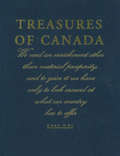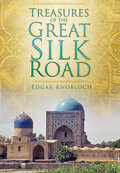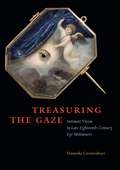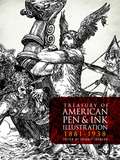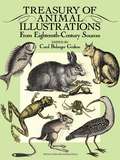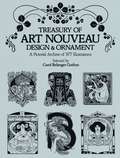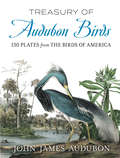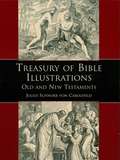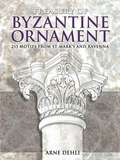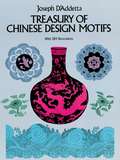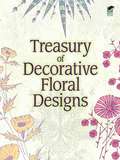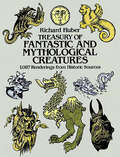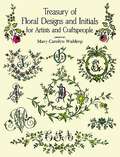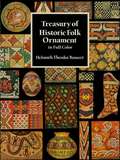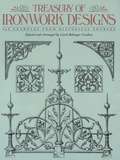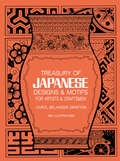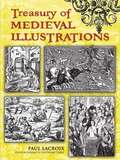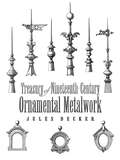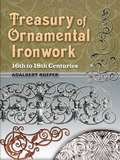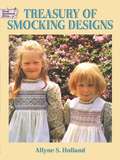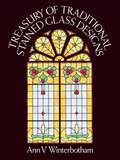- Table View
- List View
Treasures Of Canada
by Alan Samuel John De VisserThis tome is an extensive record of Canadas treasures including art, architecture, historical sites, and spots of natural beauty.
Treasures of the Great Silk Road
by Edgar KnoblochTurkestan – the great landmass of Central Asia and Western China – is an intriguing meeting point of civilizations. Four major invasions – Greek, Arab, Mongol and Russian – together with Persian, Turkic and Chinese cultural influences, have made their mark on this vast and sometime forbidding region. The Great Silk Road ran to the West through it, while nomad and urban peoples combined over the centuries to produce a cultural flowering under Timur and his successors in the late medieval and early modern periods, through a rich profusion of artistic and architectural styles and ornament. In this comprehensive account of the culture and history of Central Asia, Edgar Knobloch describes the main centres of our human civilization. He spices the text with quotations from the works of contemporary travellers, while providing an expert’s commentary on the archaeological, architectural and decorative features of the sites he describes. The stunning and evocative photographs are supplemented by numerous maps, incorporating the recent developments in the region’s borders and frontiers. With up-to-date information on borders, check points and visas, Treasures of the Great Silk Road should appeal not only to scholars and those interested in the great cultural heritage of this region, but also to travellers to the region.
Treasuring the Gaze: Intimate Vision in Late Eighteenth-Century Eye Miniatures
by Hanneke GrootenboerThe end of the eighteenth century saw the start of a new craze in Europe: tiny portraits of single eyes that were exchanged by lovers or family members. Worn as brooches or pendants, these minuscule eyes served the same emotional need as more conventional mementoes, such as lockets containing a coil of a loved one’s hair. The fashion lasted only a few decades, and by the early 1800s eye miniatures had faded into oblivion. Unearthing these portraits in Treasuring the Gaze, Hanneke Grootenboer proposes that the rage for eye miniatures—and their abrupt disappearance—reveals a knot in the unfolding of the history of vision. Drawing on Alois Riegl, Jean-Luc Nancy, Marcia Pointon, Melanie Klein, and others, Grootenboer unravels this knot, discovering previously unseen patterns of looking and strategies for showing. She shows that eye miniatures portray the subject’s gaze rather than his or her eye, making the recipient of the keepsake an exclusive beholder who is perpetually watched. These treasured portraits always return the looks they receive and, as such, they create a reciprocal mode of viewing that Grootenboer calls intimate vision. Recounting stories about eye miniatures—including the role one played in the scandalous affair of Mrs. Fitzherbert and the Prince of Wales, a portrait of the mesmerizing eye of Lord Byron, and the loss and longing incorporated in crying eye miniatures—Grootenboer shows that intimate vision brings the gaze of another deep into the heart of private experience. With a host of fascinating imagery from this eccentric and mostly forgotten yet deeply private keepsake, Treasuring the Gaze provides new insights into the art of miniature painting and the genre of portraiture.
Treasury of American Pen & Ink Illustration 1881-1938 (Dover Fine Art, History of Art)
by Fridolf Johnson"Looking for a good book? Treasury of American Pen & Ink Illustration 1881-1938 is a coffee-table-style book of outstanding black and white art that is magnificent to look through and should be in every art lover's home." -- Rushford Public LibraryA combination of technological advances and a vast reservoir of native talent led to a golden age in American illustration during the period between the Gilded Age and the dawn of World War II. Popular magazines such as Century, Scribner's, Puck, and Life launched the careers of many aspiring illustrators, including Edwin Austin Abbey, Howard Pyle, Maxfield Parrish, Frederic Remington, Charles Dana Gibson, Rockwell Kent, and many others. This collection features more than 230 reproductions of the finest pen-and-ink drawings by more than 100 artists during the heyday of the illustrated magazine, from 1881 to 1938. In addition to images from popular magazines, the survey features illustrations from newspapers and books that recapture a broad range of expressions of artistic imagination and experimentation. The compilation includes an informative Introduction by designer and art historian Fridolf Johnson, which traces the history and development of pen-and-ink illustration and chronicles America's richly varied illustrative tradition and artistic heritage.
Treasury of Animal Illustrations: From Eighteenth-Century Sources
by Carol Belanger GraftonWondrous panorama of the animal kingdom, with detailed reproductions of over 600 rare engravings: mammals, birds, reptiles, amphibians, fish, crustaceans, insects, some plants -- all identified. Royalty-free illustrations for designers and craftspeople. Excellent sourcebook for students of natural history.
Treasury of Art Nouveau Design & Ornament (Dover Pictorial Archive)
by Carol Belanger GraftonOrnament is the essence of Art Nouveau. Throughout their two decades of dominance, Art Nouveau artists concentrated on the ornamental and decorative potential of the flowing line in painting, printing, wallpaper, and all other fine and applied arts. Hundreds of thousands of carefully wrought designs embellished books, bookplates, furniture, and appliances. A fashionable home was a garden of graphic florals, petals, leaves, and stems.Today, Art Nouveau is again attracting artists, designers, and craftsmen of all kinds, while these countless ornamental flourishes have perished with their ephemeral surroundings. Art Nouveau motif seekers have been left with little choice but to resort to expensive archives of rare books. Here, taken directly from those rare books and periodicals, are 577 royalty-free authentic period designs specially chosen for artists and designers. The ornaments range in size from full-page illustrations to borders, head and tailpieces and decorative initials. All are in black-and-white line, clearly reproduced.Many of the creations come from the influential English periodical The Studio (1894–1920) and the French Art el Décoration (1897–1910); others from a variety of original European sources, all identified. Artists represented include Gustav Klimt, George Auriol, Ethel Larcombe, and Will Bradley, along with hundreds of English. French, Italian, German, Scandinavian, and American studio draftsmen, all identified when possible. The designs are grouped by subject matter: florals, landscapes, figures, etc. There are spot illustrations, bookplates, menus, title pages, and many, many swirling line forms.
Treasury of Audubon Birds: 130 Plates from The Birds of America
by John James AudubonThe most famous work by America's premier ornithological artist, The Birds of America presented 435 large, hand-colored engravings depicting more than 1,000 birds of 489 species. John James Audubon's historic volume, completed in 1838, was succeeded by the smaller lithographic illustrations of the much more affordable yet highly collectible octavo edition. This new collection contains 130 select plates from the octavo version, featuring splendid, scrupulously accurate portraits of the snowy egret, wild turkey, brown pelican, screech owl, and more. The birds are identified by both the common names used by Audubon and their modern equivalents. The culmination of the nature illustrator's career, these stunning works offer realistic portrayals of American birds in elegantly spare settings. An informative Introduction outlines the artist's life and his work and provides background on the creation of the octavo edition.
Treasury of Bible Illustrations: Old and New Testaments (Dover Pictorial Archive)
by Julius Schnorr von CarolsfeldPainstakingly reproduced from a rare volume of German engravings, this splendid work comprises all of the Bible's best-loved, most-quoted stories. Imaginative illustrations depict 105 episodes from the Old Testament and 74 scenes from the New Testament, accompanied by a citation of chapter and verse and the King James Version of the text.
Treasury of Byzantine Ornament: 255 Motifs from St. Mark's and Ravenna
by Arne DehliThe art of the Eastern Roman Empire and of its capital, Byzantium (Constantinople), found expression throughout the ancient world, particularly in Italian architecture. This superb archive of Byzantine ornament contains a wealth of decorative architectural elements derived from sixth- and seventh-century Italian buildings in Ravenna and in the Venetian church of St. Mark's.Depicted in more than 250 delicate line drawings are splendid perforated marble panels, intricately fashioned stone grilles and cornices, lavish candle brackets, elaborate stone mosaics for floors and ceilings, bronze window guards, as well as an abundance of decorative wreaths, rosettes, mouldings, and medallions.A multipurpose reference for students, artists, and designers, this archive of sumptuous, royalty-free designs will also serve as a rich source of inspiration for anyone working in the fine or applied arts.
Treasury of Chinese Design Motifs (Dover Pictorial Archive)
by Joseph D'Addetta284 Chinese motifs -- flowers and plants, animal life, and more. 100 plates.
Treasury of Decorative Floral Designs (Dover Pictorial Archive)
by DoverThe timeless beauty of elegant floral designs has made them prime favorites among artists and craftspeople. This rich harvest of blossoms, vines, and other floral decorations has an unlimited variety of applications, allowing them to serve equally well as individual motifs or as running borders.More than 300 delicately rendered motifs, all reproduced from a rare nineteenth-century catalog, feature a profusion of sprays, branches, and clusters. Commercial artists and designers will want them for projects calling for floral centerpieces, stripes, and allover patterns. Craftworkers will find the designs suitable for embroidery, textile patterns, woodworking, and other crafts.
Treasury of Fantastic and Mythological Creatures: 1,087 Renderings from Historic Sources (Dover Pictorial Archive)
by Richard HuberDrawing on fifty centuries of human history, this encyclopedic collection of images is filled with demons, monsters, animal-gods, totemic figures, and other supernatural beasts from the darker realms of man's imagination. Works range from prehistoric rock paintings to the drawings of Max Ernst, from the masks of black Africa to the gargoyles of Notre Dame.
Treasury of Floral Designs and Initials for Artists and Craftspeople (Dover Pictorial Archive)
by Mary Carolyn WaldrepYou'll find a thousand different uses for this practical archive of royalty-free designs with a floral theme. It includes over 700 wonderfully graceful and imaginative designs featuring flowers, leaves, and vines in delicate interlacements. Most incorporate elaborately embellished letters, initials, monograms, and names.Needleworkers, fabric painters, and other craftworkers will love browsing through these pages for the perfect design to personalize towels, handkerchiefs, bed linens, clothing, and more. Textile designers, graphic artists, and calligraphers will also find the volume brimming with useful ideas and models for creating rich floral designs, illustrated letters, borders, and frames.
Treasury of Flower Designs for Artists, Embroiderers and Craftsmen
by Susan GaberA hundred garden favorites rendered in black-and-white line illustrations will suggest numerous design and artistic uses to artists, designers, craftsmen, needleworkers. Amaryllis, anemone, begonia, cinquefoil, peony, snapdragon flow and weave, many forming borders and frames. All drawings royalty-free.
Treasury of Historic Folk Ornament in Full Color
by Helmuth Theodor BossertRich collection of attractive, highly usable folk motifs spans broad range of historical periods and cultures -- from ancient Egypt to early 20th-century Japan. Over 700 designs, brimming with native imagination and invention, include examples of decorative artwork derived from textiles, pottery, clothing, masks, tapestries, and other original sources. All royalty-free.
Treasury of Ironwork Designs: 469 Examples from Historical Sources (Dover Pictorial Archive)
by Carol Belanger GraftonThe history of Western decorative arts is filled with splendid examples of ornamental ironwork — elaborately wrought designs for gates and fences, finials and posts, banisters, window grilles, signs and marquees, cathedral screens, and a host of other architectural and decorative features. This practical archive brings together nearly 500 outstanding examples of the ironmaker's art. Meticulously rendered in fine black-and-white line art, the designs have been reprinted from rare European and American catalogs and periodicals of the nineteenth and early twentieth centuries, including L'Art Pour Tous, Art Journal, The Illustrated London News, Harper's Monthly, and others.The designs illustrated here date from the Middle Ages through the nineteenth century, encompassing the ornate figuration of the Renaissance, the exuberant innovations of Baroque and Rococo artists, and the sinuous designs of nineteenth-century ironworkers inspired by the Art Nouveau aesthetic. Artists, architects, designers, and craftspersons will find this volume an ideal sourcebook of beautiful designs — all royalty-free — from a great tradition in the decorative arts.
Treasury of Japanese Designs and Motifs for Artists and Craftsmen (Dover Pictorial Archive)
by Carol Belanger GraftonA profound sense of the aesthetic beauty in all things pervades the whole of Japanese culture, finding perhaps its clearest expression in the decorative, applied, and pictorial arts. Characterized by a mastery of line and composition, and noted for lyrical scenes of exquisite beauty, the genius of Japanese art has bequeathed to the world a remarkable and distinctive design legacy. This exceptionally versatile collection of traditional Japanese designs and motifs presents the working artist with a treasury of 360 copyright-free designs. All have been especially adapted by noted artist Carol Belanger Grafton for ready use by illustrators, designers, and craftspeople. Painstaking effort has been made to preserve the original spirit and subtlety of detail while simultaneously sharpening the lines and enhancing the reproducibility of the designs and motifs. There are several lovely ceramic and textile patterns. However, most of the design motifs in this compendium were taken from woodblock prints. This particular medium was invented in China and introduced to Japan before 1000 A.D., flourishing thereafter and reaching its zenith in the Ukiyo-e ("floating world") school of the 17th, 18th, and 19th centuries. Accompanying these depictions of people in traditional garb, and accessories such as fans, keys, kites, and umbrellas, are many charmingly decorative family crests arranged in mostly circular configurations. Also included are full-page compositions of bold geometric design, vignettes of ethereal delicacy, as well as a generous sampling of nature's bounty: cherries, radishes, plum blossoms, lions, elephants, dogs, cranes, parrots, turtles, butterflies, even demons and dragons, and much more―often in several arrangements, many with reversed images.Artists, designers, illustrators, students, and teachers will find this indispensable collection of 360 traditional Japanese designs and motifs rendered in clean, crisp, black-and-white, copyright-free illustrations to be a remarkably fertile source of illustrative inspiration and design solutions.
Treasury of Medieval Illustrations (Dover Pictorial Archive)
by Carol Belanger Grafton Paul LacroixA Rich Archive of Medieval Vignettes From Authentic Pages of HistoryIn this artful look back at the fascinating facets of medieval society, the realms and reveries of the Middle Ages unfold in more than 750 black-and-white illustrations. Crisp depictions of battling warriors, everyday business and industry, architectural motifs, religious and secular celebrations, calligraphy, beasts of myth and legend, and other elements of daily medieval life and beliefs abound. Masterfully reproduced from rare sources, these genuine images were created by artists throughout medieval Europe. Ideal for use in a broad spectrum of graphic and craft projects, this treasury of illustrations will also delight students and enthusiasts of history.
Treasury of Nineteenth-Century Ornamental Metalwork
by Jules DeckerExtremely pliable yet amazingly durable, metal offers infinite decorative options. Here are 1,000 prime examples of French metal masterworks, painstakingly reproduced from an extremely rare and valuable edition. From the everyday to the ornate, items include:Weather vanesTilesWaterspoutsTrimsBasinsPike headsYou'll also find hundreds of other images, offering a wealth of inspiration and useful historical designs.
Treasury of Ornamental Ironwork: 16th to 18th Centuries
by Adalbert RoeperSixty vintage black-and-white plates illustrate the history of German decorative ironwork from the16th to the 18th centuries. A hard-to-find celebration of the diversity and enduring beauty of Germany's handcrafted iron embellishments, this magnificent edition exhibits striking views of metal doors, balconies, window arches, gates, corner pieces, decorative accessories, and more, many wrought with gargoyles, human figures, and florals. A rich source of inspiration and an accurate, invaluable reference for art historians, architects, craftworkers, and designers.
Treasury of Smocking Designs
by Allyne S. HollandSmocking, the venerable English peasant craft dating from the late eighteenth century, was a needle technique originally used to adorn the traditional rural work chemise. Today's needleworkers will welcome this collection of 22 beautiful smocking patterns by noted designer Allyne Holland, as well as an informative discussion of smocking traditions, materials, fabric preparation, stitching techniques, and all the finishing touches.Make an exquisite yoke or a pocket for a favorite blouse, ornament pillows and evening bags, embellish children's clothing with baskets or butterflies, and create countless other special items using the charming patterns provided. Ranging in difficulty from intermediate to advanced, the patterns divide into four basic groups: Geometric Smocking, Cross-Over Combinations, popular Picture Smocking, and Advanced Designs. Choose from "Victorian Memories," "Katie's Best," "Magic," "Rosina's Garden," "Madeira Lace," and many other beautiful designs.A valuable section on stitching techniques presents clear step-by-step instructions and helpful diagrams for dozens of straight stitches, wave stitches, stitch combinations, and decorative or accent embroidery stitches -- including cable stitch, honeycomb stitch, trellis stitch, satin stitch, lazy daisy stitch, and many more. In addition, you'll find easy-to-follow smocking graphs for each design, stitch keys, and a useful glossary of smocking terms.
Treasury of Traditional Stained Glass Designs
by Ann V. WinterbothamStained glass windows have for centuries adorned spectacular churches, massive government buildings, and stately homes of the well-to-do. But during the Victorian era, stained glass was increasingly used as an integral part of the design of middle-class, single-family homes. This impressive volume is the largest collection of stained glass designs from actual windows. All of the nearly 400 designs can be characterized as traditional and domestic; they are copied from windows in residences and do not include any religious work. They are secular in motif and richly varied in design. As all designs are from actual windows, the practicality of their craft is assured. The development of popular stained glass in many ways parallels the larger art movements of the era. Victorian windows often have a double border -- the outer clear, the inner ruby red or, less commonly, blue. The geometric designs based on circles, squares, and triangles are pale tints of subtle colors: olive green, ochre, yellow, amber, pink, mauve, light blue. In many of these windows, the geometric borders are augmented by birds, flowers, berries, and leaves in dark, rich tones of red and green as the central illustration.As the Victorian era gave way to the Edwardian, one sees an increase of yellows and opaques accompanied by a wider range of textures and relief patterns. Victorian windows are usually all color, whereas the Edwardian approach emphasized brighter rooms and so used clear glass, making for a rich and sparkling play of contrasting textures. In late Victorian and Edwardian windows, hints of Art Nouveau curves and ovals soften earlier geometry. The influence of Art Deco revived the popularity of geometric designs in the 1920s and '30s. These recent works however, have a more accentuated diagonal, vertical, and horizontal style and make use of clear, bright colors.This stunning and comprehensive collection of popular stained glass designs will be invaluable to students of the craft, architectural historians, and many graphic artists as a rich and varied source of design and ornamentation that can be directly applied to the most modern graphic challenges. By accurately rendering hundreds of stained glass windows, graphic artist and designer Ann Winterbotham has saved for posterity many fine designs that will soon fall prey to the ravages of time or the wrecker's ball.
Treat Too!: Two Tails Are Better Than One
by Christian VielerFrom the bestselling author of Treat! comes the second ulti-mutt collection of lovable and hilarious photographs of dogs vying for treats -- now with double the pups for even more paw-some fun! Photographer Christian Vieler is an online sensation for pup-arazzi worthy photos of dogs. In Treat! he captured 60 dogs anticipating, catching -- some more successfully than others -- and enjoying a scrumptious snack. In Treat Too, Vieler brings twice the pups, and twice the fun. From a pair of tenacious terriers to a duo of goofy golden retrievers, these hilarious and paws-itively beautiful photographs capture each dog's unique personality in a way any dog owner will recognize and enjoy! Purrfect for the animal lover in your life, these adorable photos will have you rolling over and howling with laughter and love.
Treat Yourself!: How to Make 93 Ridiculously Fun No-Bake Crispy Rice Treats
by Jessica SiskinIt all began with a giant cheeseburger-shaped rice crispy treat, created on a whim and posted online. Since then, Misterkrisp, aka food artist Jessica Siskin, has become an Instagram sensation with her joy-inducing, pop-culture-inspired treats.Treat Yourself! is the perfect answer for any cook, crafty food lover, or creative parent looking to make crowd-pleasing and personalized treats for birthdays, holidays, school events, and virtually every other occasion. With no baking required, these playful, visually dazzling sweets are simple enough for anyone to whip up. Each of the 93 projects, arranged from Apple to Zebra, starts with a single base recipe. There are large, cake-sized treats to share and individual-sized treats perfect for bake sales and goody bags. Step-by-step instructions, vibrant illustrations, and downloadable templates ensure that anyone, with any level of skill, can turn out delicious, eye-catching creations: Lively designs for kids’ parties—Robot, Dinosaur, Crown, Balloons. A Cheeseburger. A Statue of Liberty. A Dancing Lady Emoji. And a sweet centerpiece for your next Super Bowl bash: a Football Stadium filled with sprinkle spectators. It’ll serve the neighborhood! Treats have never been so much fun or so doable.
Treat!
by Christian VielerWho's a good dog? In the tradition of bestselling photography books like Underwater Dogs and Shake comes an adorable and hilarious collection of dog photographs capturing our best friends at one of their favorite moments--treat time. Photographer Christian Vieler caught these eager dogs anticipating, catching--some more successfully than others--and enjoying a scrumptious tidbit.From a tenacious terrier to a goofy golden retriever, these often hilarious and surprisingly beautiful photographs capture each dog's unique personality in a way any dog owner will recognize and that all dog lovers will enjoy!
